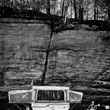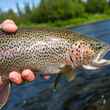Crest the ridge on Fisherman’s Drive overlooking the Henry’s Fork, and it’s easy to see why this river contains the closest thing to Holy Water that can be found without the Pope’s blessing. Even in the dead of winter, its banks blanketed in snow and its edges glassed with a thin sheen of ice, this river simply looks sacred.
Certainly there are more sacred stretches, however, but I’ve always found myself drawn to this length of the Henry’s Fork. Here, below the confluence with the Warm River, it slices through a foothill canyon and tumbles and rolls through a series of riffles and runs for about 10 miles before it slams against Ashton Dam. Fish in this stretch have shoulders—they have to.

And I love this run of water in the winter—starting about right now through March, as the days get a longer and the fleeting sunshine hits the river a few minutes longer than the day before, swarms of midges and, later, blue-winged olives, hatch along this reach and bring the rivers browns and rainbows to the top. Whitefish, too, live in this water, and they’re dependable winter fare, as well.
No, this isn’t the fabled Railroad Ranch or the Box Canyon sleigh ride. Boaters can take this stretch of water on, but it’s forgiving to footbound anglers, too (especially if you spike your wading boots—just sayin’). The hatches are about as dependable as one could expect during the snowy months, and if you can find rising fish, you’ll find trout that will hit midge patterns dependably (although, I almost always fish over a hatch with a small midge pupae pattern trailed by a larger Prince nymph—the midges are tiny and plentiful and getting the fish to hit yours can be a real challenge).
On the cloudy days, earlier in the winter season (December-February), stripping streamers can work really well. Buggers, Zonkers and the like will attract the river’s aggressive browns and rainbows, usually on the swing, and you’ll be surprised what a whitefish can fit in its mouth—I had one hit a size 4 sculpin on the retrieve in early January that might have pushed 20 inches.

And winter is the best time of year to visit this area if you’re a fan of snow and the serene white-cloaked landscape of Island Park (if you can get away from the snowmobile trails). You’ll likely catch glimpses of trumpeter swans along the river’s storied reach above the Railroad Ranch, and in the canyon below Warm River, you’ll see at least one of the resident bald eagles that spend most of the year in this fishy paradise (that’s promising, right?).
Do yourself a favor—visit Pond’s Lodge on the shores of the Buffalo River in Island Park after a day of fishing. Stop in at the bar and rub elbows with snow machine riders who reek of two-stroke gas and love to party. Then, just to be safe, check into a cabin, get a good night’s sleep, and do it all again the next day.
Bring your favorite 5-weight and a good assortment of typical winter flies. Start small—size 18-20 midge patterns are a must, as are small midge emergers, like Zebra Midges. Then, go a little bigger as you go deeper—size 14 Princes work, and don’t be afraid to trail a size 8 Girdle Bug, as this river is famous for its stoneflies. If you’re having trouble, stop into one of several fly shops along the river, both in Island Park and in the little town of Ashton—these folks will share the flies that working and point you in the right direction as far as access and fishable water are concerned.
As you wander the canyon stretch, the fishy water will be obvious. Fish below riffles and hit the pocket water around large rocks. Deeper runs scream for streamers—go heavy and go deep if you can. You won’t be disappointed.































Comments